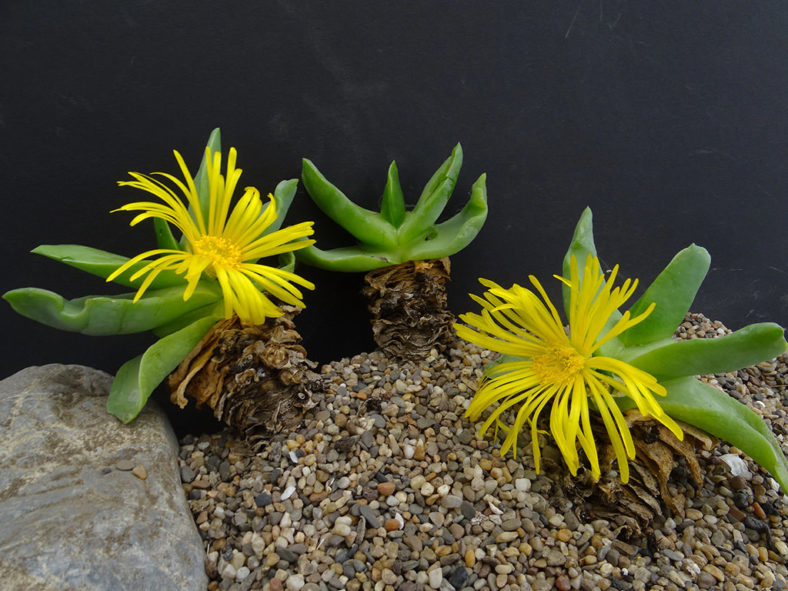Scientific Name
Glottiphyllum linguiforme N.E.Br.
Common Name(s)
Tongue Leaf Plant, Tongue Plant
Synonym(s)
Mesembryanthemum linguiforme
Scientific Classification
Family: Aizoaceae
Subfamily: Ruschioideae
Tribe: Ruschieae
Genus: Glottiphyllum
Etymology
The specific epithet "linguiforme (pronounced lin-GWEE-form-ee)" means "tongue-shaped" and refers to the shape of the leaves.
Origin
Glottiphyllum linguiforme is native to South Africa. It occurs in the central part of the arid Little Karoo near Oudtshoorn in the Western Cape, growing under shrubs on loamy sands with quartzite.
Description
Glottiphyllum linguiforme is a small, spreading succulent with few short, decumbent branches and grey-green, tongue-shaped leaves arranged in two opposite vertical rows. It forms dense clumps and can grow up to 2.6 inches (6.5 cm) tall and 12 inches (30 cm) in diameter. The leaves are flushed bronze to purple when the plant goes dormant in summer. They are ascending to erect, rather flat, narrowing to the base, measuring up to 2.6 inches (6.5 cm) long and 1.8 inches (4.5 cm) wide. The leaves may be up to 5 inches (12.5 cm) long and 3 inches (7.5 cm) wide in robust specimens.
The large, yellow, daisy-like flowers have many narrow, radiating petals and appear in winter and spring. They can reach up to 2.8 inches (7 cm) in diameter. The seed capsules have a conical, somewhat woody base and fall off the plant when they dry, becoming tumble fruits and spreading the seeds.
Glottiphyllum linguiforme is similar to Glottiphyllum carnosum but is less branched and has flatter leaves.

How to Grow and Care for Glottiphyllum linguiforme
Light: This succulent needs bright light but does not like too much direct sun. A sunny windowsill where the plant receives 4 to 5 hours of direct sunlight during the early part of the day and partial shade during the afternoon is the perfect spot to grow your G. linguiforme indoors.
Soil: G. linguiform thrives best in porous soil mixes that allow water to drain away quickly. You can use a commercial potting mix specially designed for succulents or make your own.
Temperature: This plant tolerates high summer temperatures by going dormant. G. linguiforme can withstand temperatures as low as 10 °F (-12.2 °C). USDA Plant Hardiness Zones 8a to 10b, 10 to 40 °F (-12.2 to 4.4 °C).
Watering: G. linguiforme requires little or no water when it goes dormant, usually in summer. When it begins to grow again in fall, it is safe to water deeply, allowing the soil to dry before between waterings. If leaves start to wrinkle during the growing season, your plant needs water.
Fertilizing: This small succulent is a light feeder and does not need fertilizer if repotted every two years.
Repotting: G. linguiform will stay in the same pot for several decades. Repotting is commonly done to give the plant a larger growing space. The best time to repot this plant is at the beginning of its active growth period, but it can be done at almost any time while actively growing.
Propagation: This species is easily propagated by stem cuttings and seeds. The best time to take cuttings is at the end of summer. Sow the seeds in a pot with a well-drained soil mix in spring.
Learn more at How to Grow and Care for Mesembs.
Toxicity of Glottiphyllum linguiforme
G. linguiforme is considered non-toxic to humans and pets.
Links
- Back to genus Glottiphyllum
- Succupedia: Browse succulents by Scientific Name, Common Name, Genus, Family, USDA Hardiness Zone, Origin, or cacti by Genus
Photo Gallery
Click on a photo to see a larger version.


